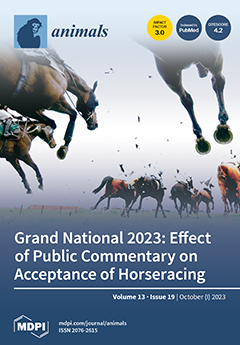Giant pandas are the flagship species in world conservation, and include two subspecies,
Ailuropoda melanoleuca qinlingensis (
A. m. qinlingensis) and
Ailuropoda melanoleuca sichuanensis (
A. m. sichuanensis). Hematology and serum biochemistry studies are crucial to protecting giant pandas. Even though research on hematology and serum biochemistry are well-established in
A. m. sichuanensis, research in
A. m. qinlingensis is scarce. The study aimed to (1) establish a baseline for hemogram and reference intervals (RIs) for hematological and serum biochemical parameters in
A. m. qinlingensis, (2) assess the possible variations in these parameters of
A. m. qinlingensis based on age, gender, and storage condition of blood samples, and (3) compare the parameters to those of
A. m. sichuanensis. Blood samples (
n = 42) were collected from healthy
A. m. qinlingensis (
n = 21) housed in Shaanxi (Louguantai) Rare Wildlife Rescue and Breeding Research Center, and hematological (
n = 25) and serum biochemical parameters (
n = 18) were analyzed in March and December of 2019. The results showed no significant abnormality in the blood smears of all individuals in this study, except for a few serrated red blood cells, platelet aggregations, and occasionally giant platelets. Between sub-adult and adult
A. m. qinlingensis, there were significant differences in five hematological and one serum biochemical parameter (
p < 0.05), whereas six serum biochemical parameters were present when α = 0.1 (
p < 0.1). Gender influenced % NEU, % LYM, % EOS, LYM, EOS, GGT, and CHOL of
A. m. qinlingensis. The majority of the hematological and serum biochemical parameters of
A. m. qinlingensis were different from those of
A. m. sichuanensis regarding age and gender. The anticoagulant whole blood samples of
A. m. qinlingensis stored at 2–8 °C for 24 h and the serum samples stored at −18 °C for 48 h had little influence on the values of hematological and serum biochemical parameters. In conclusion, this study provided a baseline of hemogram and established RIs for hematological and serum biochemical parameters of
A. m. qinlingensis. RIs of
A. m. sichuanensis reported before were not completely fit for
A. m. qinlingensis, and age, gender, or the storage condition of blood samples influenced some of the parameters of
A. m. qinlingensis. To the authors’ knowledge, this is the first report of a hemogram baseline and RIs for hematological and serum biochemical parameters of
A. m. qinlingensis.
Full article






